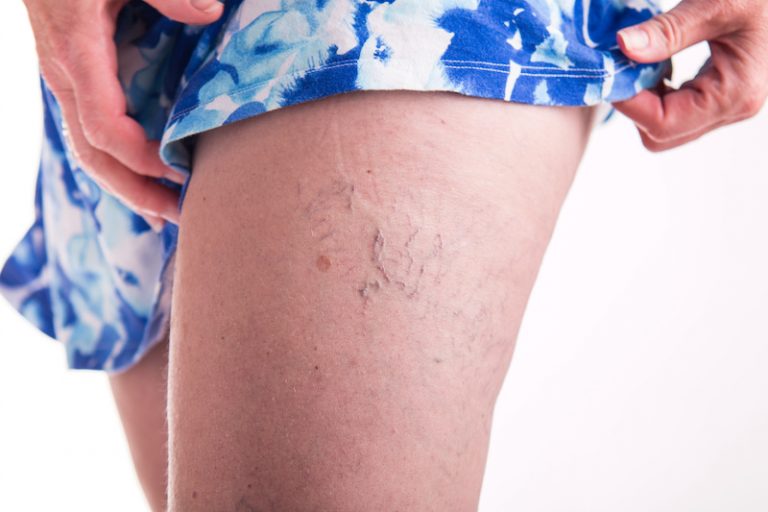People have a lot of strong feelings around spiders. Some can’t stand them and want them out of the house no matter what, while others leave them alone so that they catch more annoying insects. As Halloween approaches, we’re sure to see “spooky” spiders adorning our friends’ houses and yard. Regardless of our stance on actual spiders, we should all be able to agree that spider veins aren’t useful and should be eliminated. Many aren’t aware that they may be a sign of venous disease. Fortunately, spider veins can be wiped out with a minimally-invasive treatment called sclerotherapy.
Healthy veins bring deoxygenated blood back to the heart. Venous disease, a medical condition that affects nearly 40% of US adults, causes valves within leg veins to close improperly. Veins fight against gravity to move the blood from your feet back up to your heart. As the blood moves up the leg, valves in the veins close to prevent it from reversing direction. When these valves weaken or stop functioning, however, the blood can pool and stretch the vein walls, which may lead to the appearance of varicose veins and spider veins. Multiple factors contribute to venous disease, including age, occupations requiring long periods of standing or sitting, genetics, childbirth or trauma. Long-term venous disease may lead to symptoms such as heaviness, aching, pain, swelling, tenderness, skin changes, restless legs, and more.

Spider veins look like tiny weblike networks of red, blue, or purple veins just under the surface of the skin and typically appear from the ankles to the upper thighs. Many patients are distressed by the appearance of spider veins from a cosmetic standpoint, but they can also be accompanied by physical discomfort such as pain, swelling, aching, and fatigue in the legs. Fortunately, sclerotherapy treatment can improve symptoms and clear the spider veins.
Sclerotherapy is a simple, effective procedure that is easily performed in an office setting. Tiny needles are used to inject a sclerosing agent into the spider veins, causing them to collapse and fade. Following sclerotherapy treatment, the appearance of your legs will improve as will the bothersome symptoms.
Sclerotherapy is considered the gold-standard treatment for these types of vein issues. Prior to receiving sclerotherapy, you should have a vein consultation with a phlebologist (a doctor who specializes in vein diseases), who will evaluate whether you are a good candidate for the procedure. Spider veins can appear in both men and women, regardless of age, though it is more prevalent in women. Treatment can also make the skin on your legs appear clearer and healthier.
The typical spider vein treatment session lasts 30 to 60 minutes. The treatment area is first cleansed with an antiseptic solution. The needles used to inject the sclerosant are small and well tolerated. For patients who are very sensitive to or concerned about pain, a light local anaesthetic can be applied. To enhance visualization during the procedure, the doctor utilizes an advanced light that illuminates the problematic veins. This lighting allows the phlebologist to locate the tiniest veins, as well as deeper reticular veins that serve as “feeder” veins to the spider vein complex.
Approximately one injection is administered for every inch of spider vein removal. In the past, highly concentrated saline was injected but today, new sclerosants make spider vein sclerotherapy essentially painless. Two to three spider vein treatments are typically required to achieve optimal results. The procedure treats only current veins. The procedure does not prevent the emergence of new spider veins in the future.
After treatment, the patient can drive home and resume regular activities. Walking is encouraged and the phlebologist will instruct the patient to wear compression stockings for a short period of time following each sclerotherapy procedure. The compression achieved by the stockings enhances the effectiveness of sclerotherapy. Compression also prevents blood from getting trapped in the veins, which can lead to pain, inflammation and darkened pigmentation.
If there is any discomfort, a patient can take an over-the-counter pain reliever like Tylenol, but should avoid anti-inflammatory drugs like aspirin and ibuprofen for at least 48 hours. Also, the doctor will recommend taking it easy for a few days after the procedure. It’s fine to go about one’s normal routine, but avoid strenuous activity or exertion. For a week after treatment, avoid hot baths, hot compresses, whirlpools or saunas, and direct sunlight. Cool showers are permissible, and the injection sites may be washed with a mild soap and tepid water.
Spider veins may seem a bit spooky, but sclerotherapy is a well-tested, effective procedure. In our clinic, we see many people who want to make their legs look better, and many others, unfortunately, who have suffered silently for many years before consulting a doctor. Even if you’re not concerned by the appearance of spider veins, or are not really bothered by any discomfort you may be experiencing, it’s important to know that untreated venous disease can get progressively worse and cause more serious issues over time. If you have been putting off treatment, or just want to improve the appearance of your legs, consider giving us a call to discuss your symptoms and arrange an appointment for a free vein screening. Our great medical team will be there with you every step of the way.